Pressure Transient Analysis for Fractured Shale Gas Wells Using Trilinear Flow Model
Abstract
1. Introduction
2. Materials and Methods
2.1. Flow Mechanism
2.1.1. Desorption Mechanism
2.1.2. Diffusion Mechanism
2.1.3. Darcy Flow
2.2. Physical Model of TriLinear Flow Model for Dual Media
2.3. Mathematical Model
2.3.1. Outer Region
- 1.
- Quasi-steady-state diffusion flow equation in matrix system
- 2.
- Darcy’s seepage equation in fracture systems
2.3.2. Inter-Region
2.3.3. Hydraulic Fracture
3. Results and Discussion
3.1. Flow Regime Division
- Wellbore Storage Stage. In this phase, the dimensionless pressure and dimensionless pressure derivative curves overlap, forming a straight line with a slope of 1. This phase typically has a short duration, primarily governed by the wellbore storage coefficient and skin effect.
- Transition Stage Post-Wellbore Storage. The duration of this stage is still mainly influenced by the wellbore storage coefficient and skin effect, representing the transition of flow from the wellbore to the fractures. The pressure derivative curve deviates, indicating a gradual shift in fluid flow from the wellbore toward interaction with the fractures and the reservoir.
- Bilinear Flow Between Fractures and Reservoir. The pressure derivative curve exhibits a straight line with a slope of 1/4, characteristic of bilinear flow. This reflects the process of fluid flow from the reservoir through the fracture system toward the wellbore. During this stage, the interaction between the fractures and the reservoir is most pronounced.
- Reservoir Linear Flow Stage. The pressure derivative follows a straight line with a slope of 1/2. The duration of this linear flow stage is affected by the permeability of the reservoir and the complexity of the fracture network.
- Desorption and Diffusion Processes in Inner Region Matrix System. This stage is characterized by a concave shape in the dimensionless pressure derivative curve, representing the desorption of gas entering the fracture system through quasi-steady diffusion from the matrix.
- Desorption and Diffusion Processes in Outer Region Matrix System. Similarly to the inner region, this stage reflects the desorption and quasi-steady diffusion of adsorbed and free gas from the matrix to the fractures in the outer region. This stage is typically prolonged due to the slower desorption and diffusion processes in the outer region matrix, significantly impacting the final production.
- System-Wide Quasi-Steady Flow Stage. In this final stage, the dimensionless pressure and pressure derivative curves coalesce and slope upward, forming a straight line with a slope of 1. This indicates that the system flow has reached equilibrium, the fluid flow rate has stabilized, and the pressure differential between the reservoir and fracture systems has gradually balanced.
3.2. Monte Carlo Simulation and Uncertainty Analysis
3.2.1. Monte Carlo Simulation
- Parameter Distribution Setup: The probability distributions of the input parameters were first determined, along with their statistical properties (e.g., mean and standard deviation). For each input parameter, we assumed a distribution, such as normal, log-normal, or uniform, depending on the physical context and available experimental data, as shown in Table 3.
- Random Sampling: Using the core principle of Monte Carlo simulation, we randomly sampled 1000 sets of data from the defined parameter distributions. Each sample corresponded to a specific combination of input parameters.
- Model Solving: For each sampled set of parameters, we incorporated them into the forward-solving process of the shale gas trilinear flow model to obtain the corresponding pressure response curve. These results reflected the variations in the pressure response under different parameter combinations.
- Statistical Analysis of Results: After completing 1000 simulations, we collected all simulation results and performed statistical analysis on the output data. This analysis yielded the probability distribution, mean, standard deviation, and other statistical properties of the output pressure responses.
3.2.2. Results Analysis
3.3. Sensitivity Analysis
3.3.1. Desorption Coefficient
3.3.2. Elastic Storage Ratio
3.3.3. Inter-Porosity Coefficients
4. Conclusions
Author Contributions
Funding
Data Availability Statement
Acknowledgments
Conflicts of Interest
References
- Javadpour, F.; Ettehadtavakkol, A. Gas Transport Processes in Shale. In Fundamentals of Gas Shale Reservoirs; John Wiley & Sons, Ltd.: Hoboken, NJ, USA, 2015; pp. 245–266. ISBN 978-1-119-03922-8. [Google Scholar]
- Yucel Akkutlu, I.; Fathi, E. Multiscale Gas Transport in Shales with Local Kerogen Heterogeneities. SPE J. 2012, 17, 1002–1011. [Google Scholar] [CrossRef]
- Wang, W.; Fan, D.; Sheng, G.; Chen, Z.; Su, Y. A Review of Analytical and Semi-Analytical Fluid Flow Models for Ultra-Tight Hydrocarbon Reservoirs. Fuel 2019, 256, 115737. [Google Scholar] [CrossRef]
- Moghanloo, R.G.; Yuan, B.; Ingrahama, N.; Krampf, E.; Arrowooda, J.; Dadmohammadi, Y. Applying Macroscopic Material Balance to Evaluate Interplay between Dynamic Drainage Volume and Well Performance in Tight Formations. J. Nat. Gas Sci. Eng. 2015, 27, 466–478. [Google Scholar] [CrossRef]
- Lee, S.-T.; Brockenbrough, J.R. A New Approximate Analytic Solution for Finite-Conductivity Vertical Fractures. SPE Form. Eval. 1986, 1, 75–88. [Google Scholar] [CrossRef]
- Ozkan, E.; Raghavan, R.; Apaydin, O.G. Modeling of Fluid Transfer from Shale Matrix to Fracture Network. In Proceedings of the SPE Annual Technical Conference and Exhibition, Florence, Italy, 20–22 September 2010; OnePetro: Richardson, TX, USA, 2010. [Google Scholar]
- Brown, M.; Ozkan, E.; Raghavan, R.; Kazemi, H. Practical Solutions for Pressure-Transient Responses of Fractured Horizontal Wells in Unconventional Shale Reservoirs. SPE Reserv. Eval. Eng. 2011, 14, 663–676. [Google Scholar] [CrossRef]
- Stalgorova, E.; Mattar, L. Analytical Model for Unconventional Multifractured Composite Systems. SPE Reserv. Eval. Eng. 2013, 16, 246–256. [Google Scholar] [CrossRef]
- Stalgorova, E.; Mattar, L. Practical Analytical Model to Simulate Production of Horizontal Wells with Branch Fractures. In Proceedings of the SPE Canadian Unconventional Resources Conference, Calgary, AB, Canada, 30 October–1 November 2012; OnePetro: Richardson, TX, USA, 2012. [Google Scholar]
- Haeri, F.; Izadi, M.; Zeidouni, M. Unconventional Multi-Fractured Analytical Solution Using Dual Porosity Model. J. Nat. Gas Sci. Eng. 2017, 45, 230–242. [Google Scholar] [CrossRef]
- Stalgorova, E.; Mattar, L.; Zhang, J.; Huang, S.; Cheng, L.; Xu, W.; Liu, H.; Yang, Y.; Xue, Y. Effect of Flow Mechanism with Multi-Nonlinearity on Production of Shale Gas. J. Nat. Gas Sci. Eng. 2015, 24, 291–301. [Google Scholar] [CrossRef]
- Deng, Q.; Nie, R.-S.; Jia, Y.-L.; Huang, X.-Y.; Li, J.-M.; Li, H.-K. A New Analytical Model for Non-Uniformly Distributed Multi-Fractured System in Shale Gas Reservoirs. J. Nat. Gas Sci. Eng. 2015, 27, 719–737. [Google Scholar] [CrossRef]
- Zhang, L.; Gao, J.; Hu, S.; Guo, J.; Liu, Q. Five-Region Flow Model for MFHWs in Dual Porous Shale Gas Reservoirs. J. Nat. Gas Sci. Eng. 2016, 33, 1316–1323. [Google Scholar] [CrossRef]
- Zeng, J.; Wang, X.; Guo, J.; Zeng, F. Analytical Model for Multi-Fractured Horizontal Wells in Tight Sand Reservoir with Threshold Pressure Gradient. In Proceedings of the SPE Asia Pacific Hydraulic Fracturing Conference, Beijing, China, 24–26 August 2016; OnePetro: Richardson, TX, USA, 2016. [Google Scholar]
- Zeng, J.; Wang, X.; Guo, J.; Zeng, F. Composite Linear Flow Model for Multi-Fractured Horizontal Wells in Heterogeneous Shale Reservoir. J. Nat. Gas Sci. Eng. 2017, 38, 527–548. [Google Scholar] [CrossRef]
- Zhao, K.; Du, P. Performance of Horizontal Wells in Composite Tight Gas Reservoirs Considering Stress Sensitivity. Adv. Geo-Energ. Res. 2019, 3, 287–303. [Google Scholar] [CrossRef]
- Zhao, K.; Du, P. A New Production Prediction Model for Multistage Fractured Horizontal Well in Tight Oil Reservoirs. Adv. Geo-Energy Res. 2020, 4, 152–161. [Google Scholar] [CrossRef]
- Wang, Z.; Zhang, L.; Zhang, R.; Wang, R.; Huang, R. Flow Mechanism and Transient Pressure Analysis of Multi-Stage Fractured Horizontal Well. Chem Technol Fuels Oils 2022, 57, 941–954. [Google Scholar] [CrossRef]
- Guo, T.; Kou, Z.; Zhao, Y.; Wang, H.; Xin, Y. Role of Gas Multiple Transport Mechanisms and Fracture Network Heterogeneity on the Performance of Hydraulic Fractured Multiwell-Pad in Unconventional Reservoirs. Fuel 2023, 342, 127808. [Google Scholar] [CrossRef]
- Qin, J.-Z.; Zhong, Q.-H.; Tang, Y.; Yu, W.; Sepehrnoori, K. Well Interference Evaluation Considering Complex Fracture Networks through Pressure and Rate Transient Analysis in Unconventional Reservoirs. Pet. Sci. 2023, 20, 337–349. [Google Scholar] [CrossRef]
- Liang, Y.-Z.; Teng, B.-L.; Luo, W.-J. Study of the Pressure Transient Behavior of Directional Wells Considering the Effect of Non-Uniform Flux Distribution. Pet. Sci. 2024, 21, 1765–1779. [Google Scholar] [CrossRef]
- Wang, H.; Chen, L.; Qu, Z.; Yin, Y.; Kang, Q.; Yu, B.; Tao, W.-Q. Modeling of Multi-Scale Transport Phenomena in Shale Gas Production—A Critical Review. Appl. Energy 2020, 262, 114575. [Google Scholar] [CrossRef]
- Moghadam, S.; Mattar, L.; Pooladi-Darvish, M. Dual Porosity Typecurves for Shale Gas Reservoirs. In Proceedings of the Canadian Unconventional Resources and International Petroleum Conference, Calgary, AB, Canada, 19–21 October 2010; OnePetro: Richardson, TX, USA, 2010. [Google Scholar]
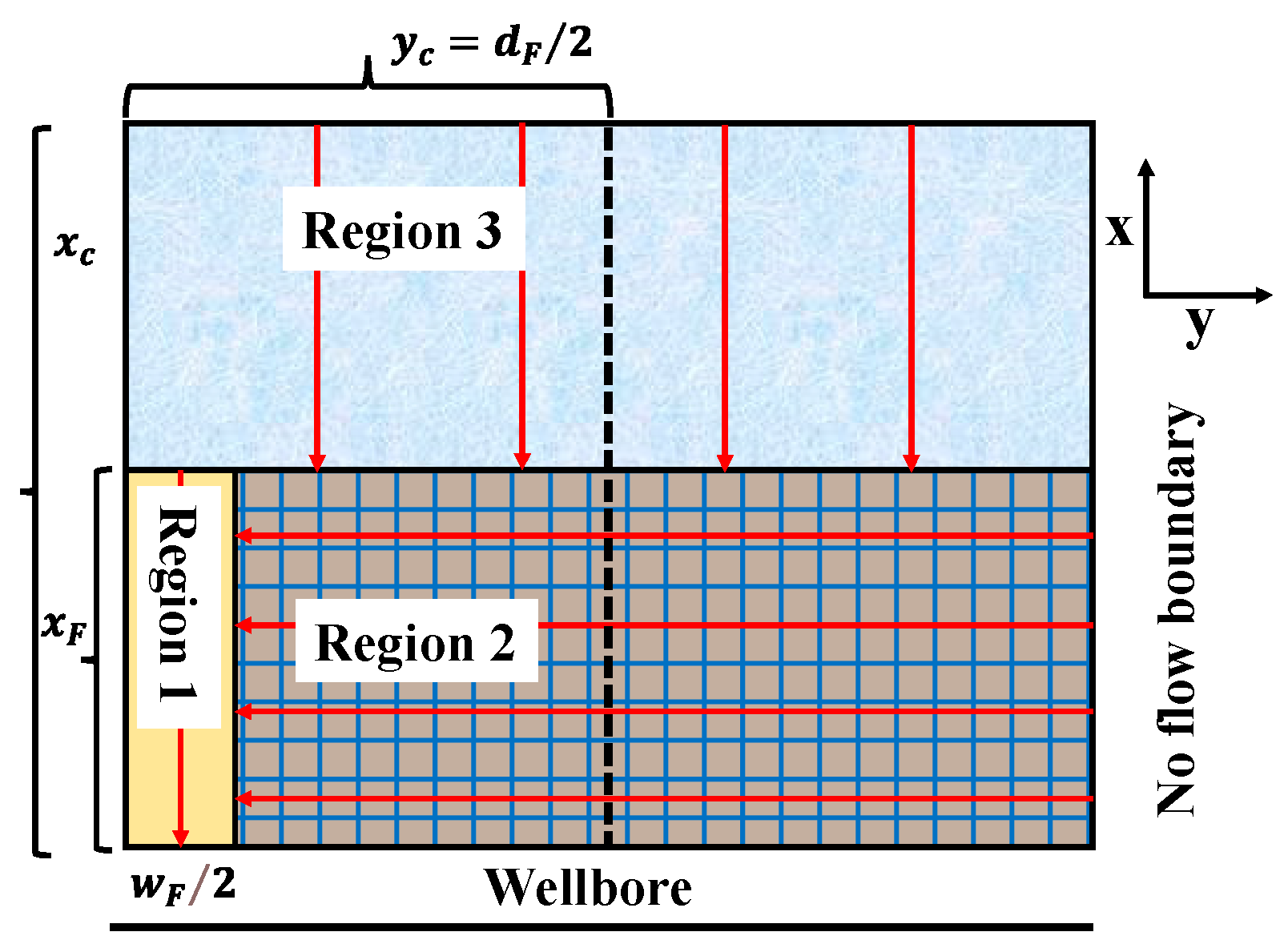
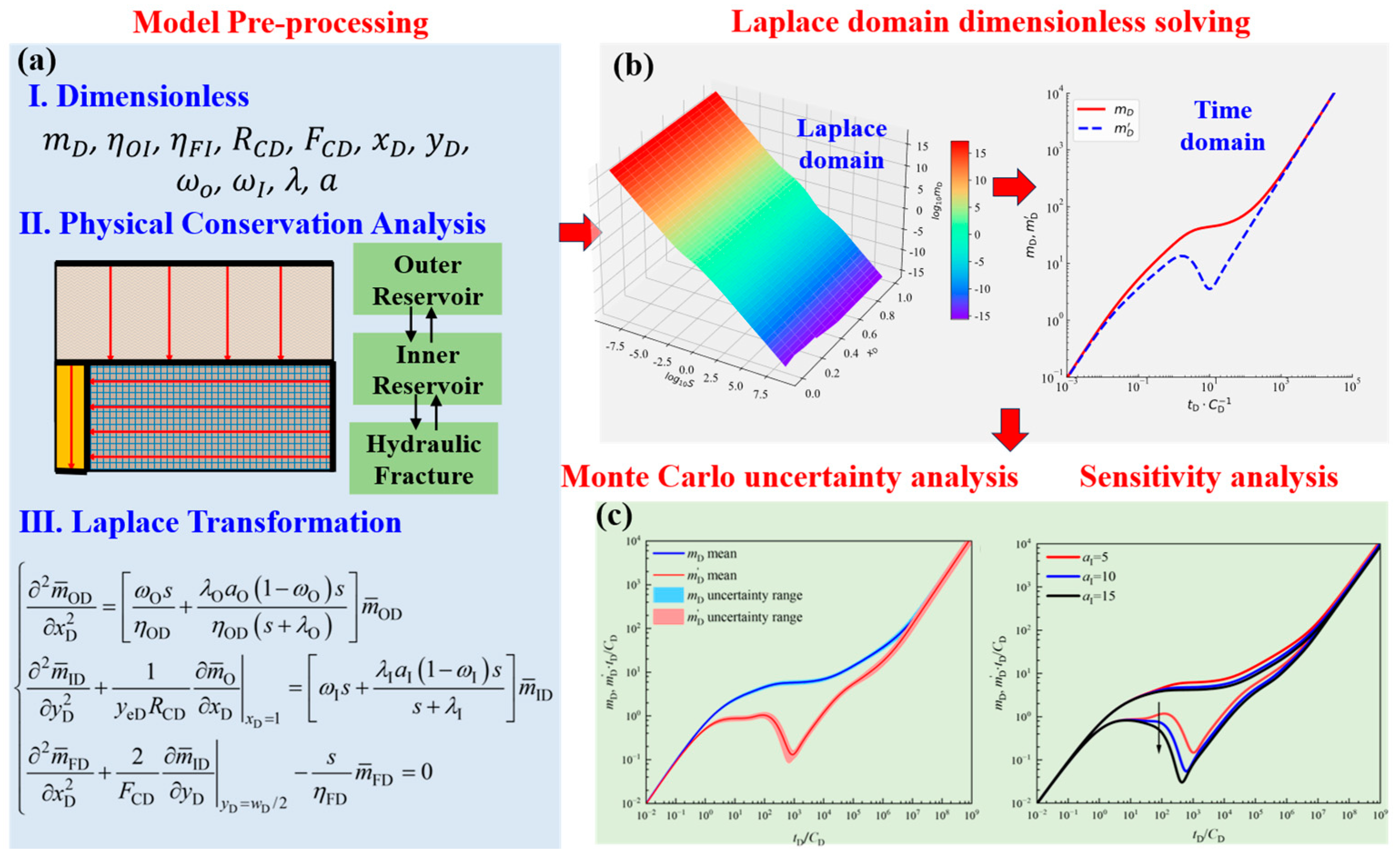
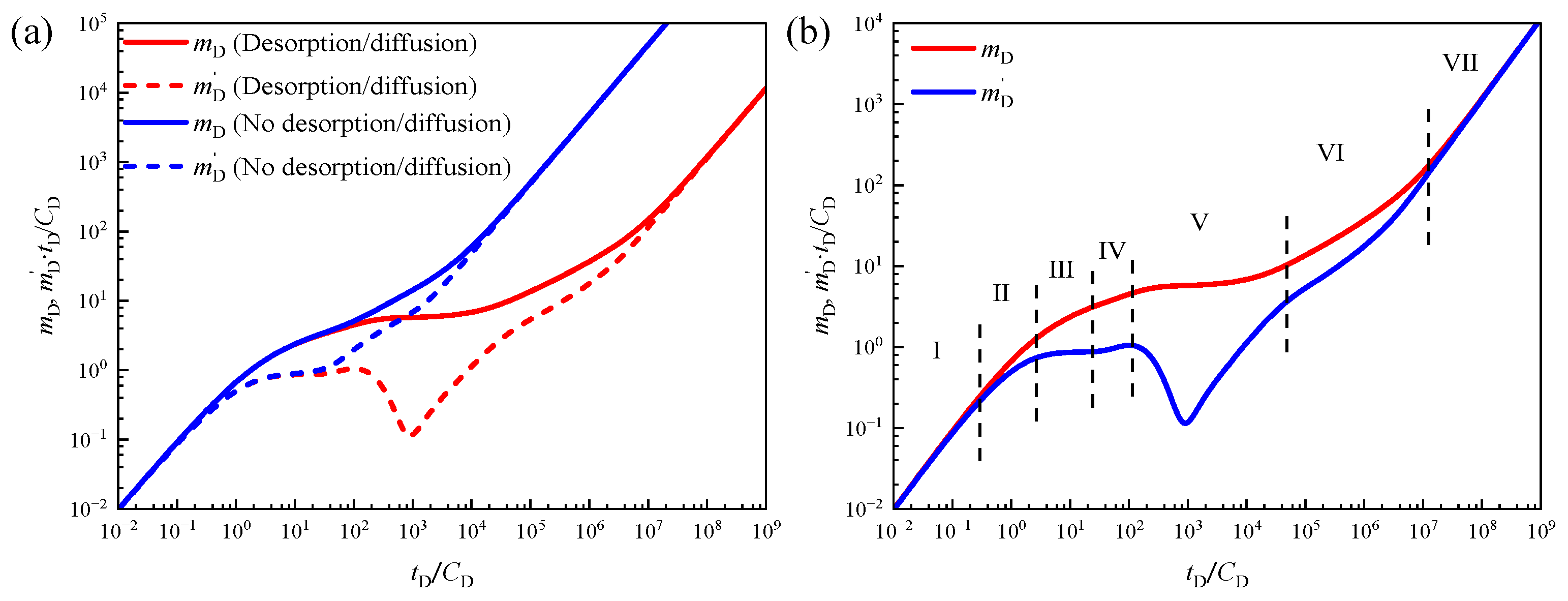
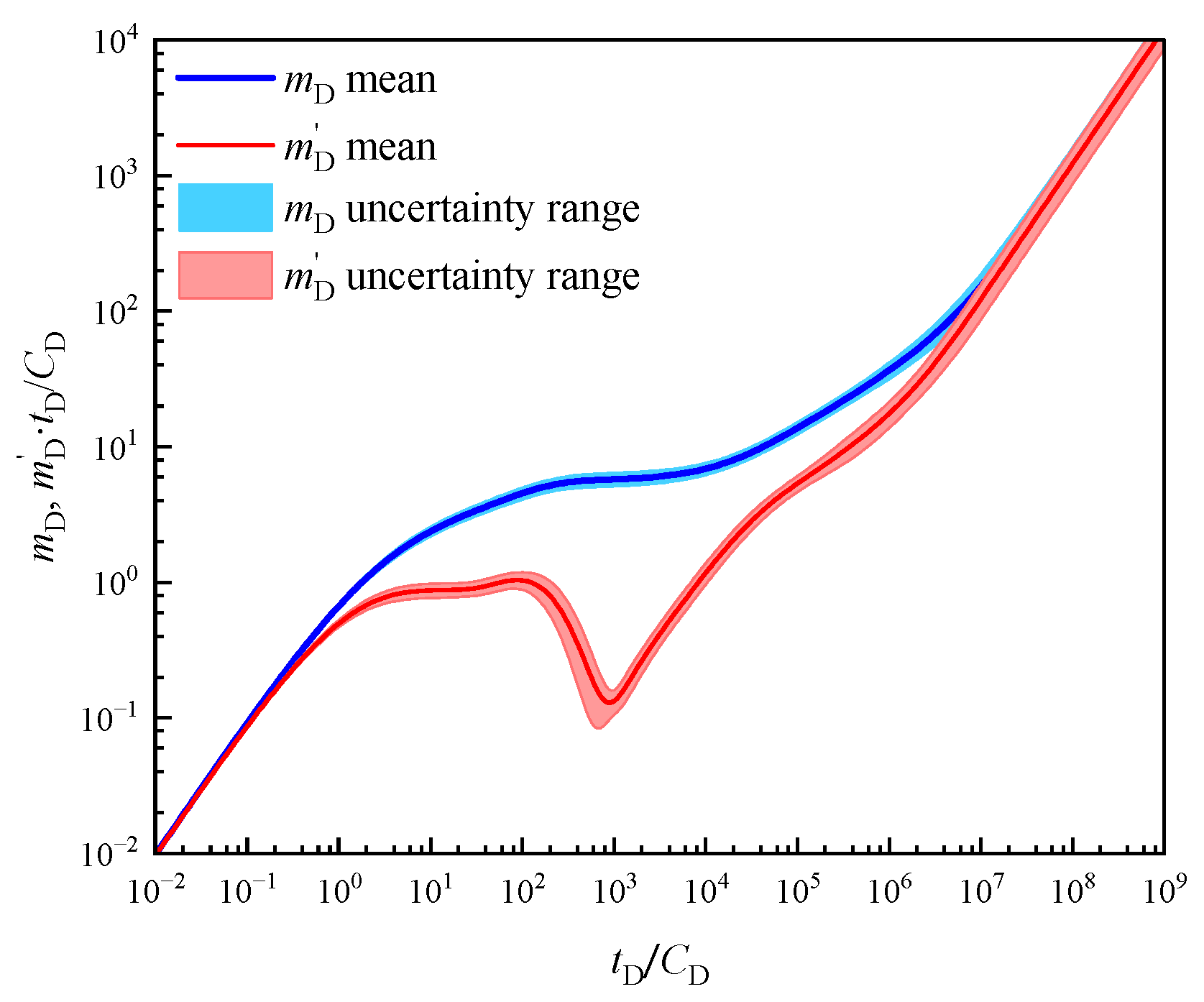
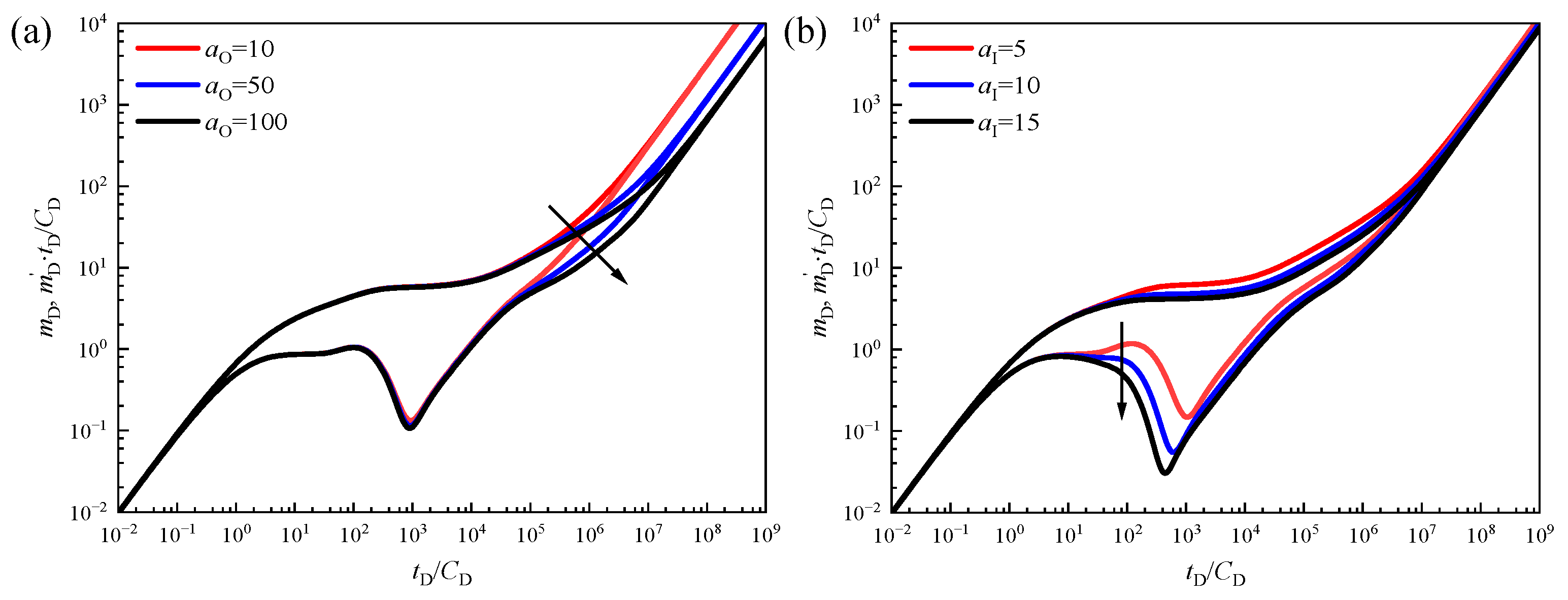
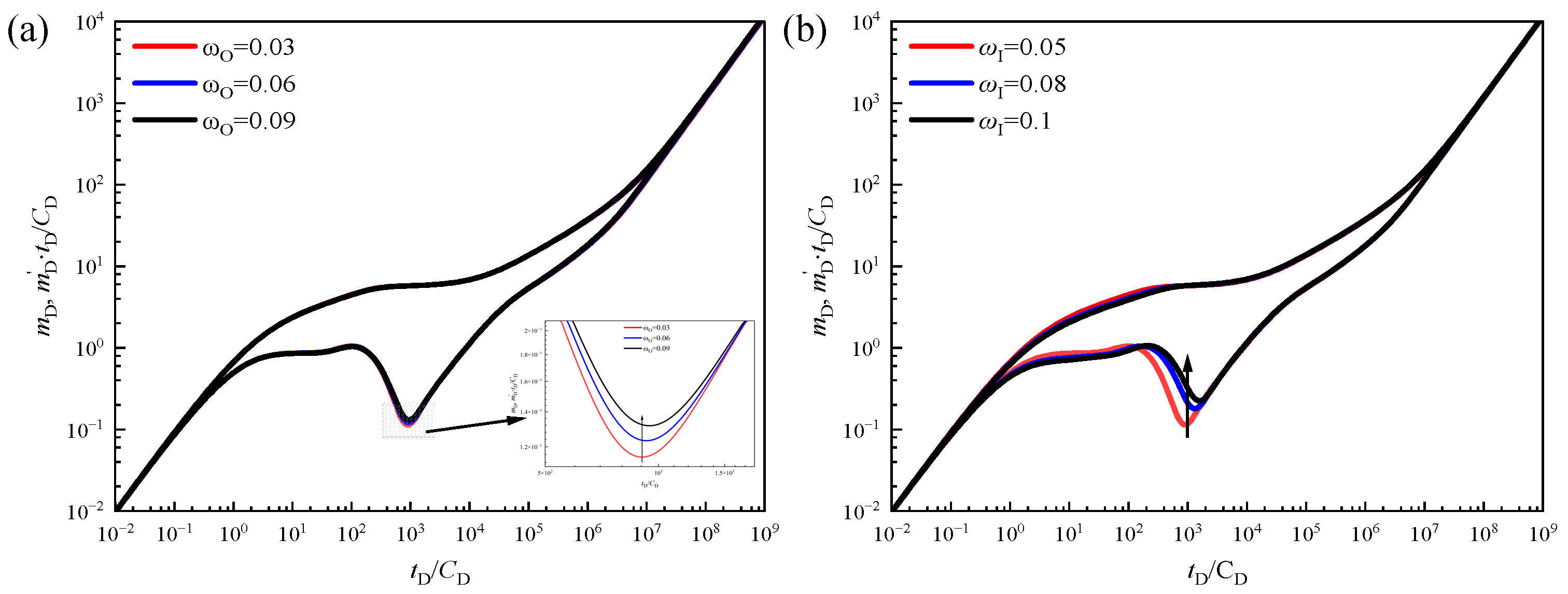
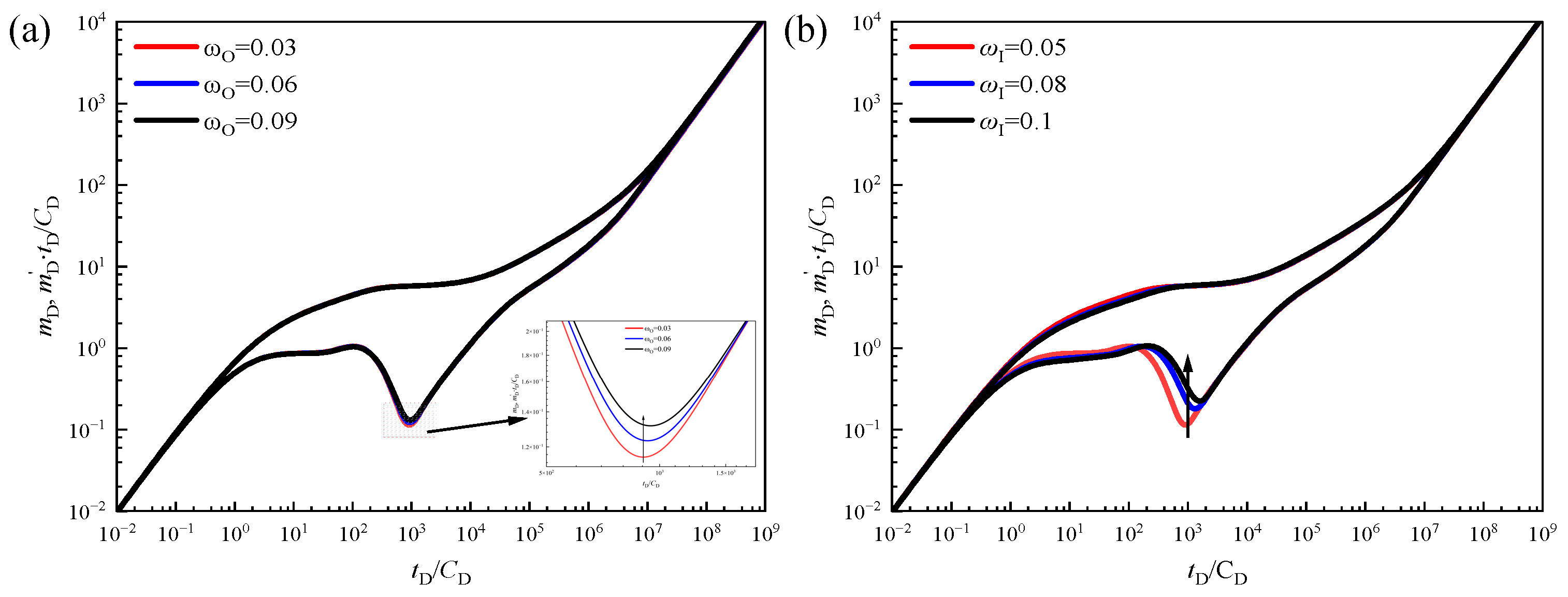
| Variables | Definition |
|---|---|
| Dimensionless pseudo-pressure | |
| Time | |
| Pseudo-pressure | |
| x-direction coordinate | |
| y-direction coordinate | |
| Diffusivity ratio | |
| Hydraulic fracture conductivities | |
| Reservoir conductivities | |
| Storativity | |
| Inter-porosity coefficients | |
| Adsorption index | |
| Associated coefficients | |
| Concentration of gas |
| Parameters | Value | Parameters | Value |
|---|---|---|---|
| 6 | 500 | ||
| 50 | 0.5 | ||
| 0.03 | 5 | ||
| 0.05 | 0.5 | ||
| 10−6 | 0.11 | ||
| 0.03 | 15 | ||
| 1.2 | 10−4 | ||
| 10−2 |
| Parameters | Mean | Variance | Parameters | Mean | Variance |
|---|---|---|---|---|---|
| 6 | 1.02 | 500 | 85.00 | ||
| 50 | 8.50 | 0.6 | 0.10 | ||
| 0.03 | 0.01 | 5 | 0.85 | ||
| 0.05 | 0.01 | 0.5 | 0.09 | ||
| 10−6 | 1.70 × 10−7 | 0.11 | 0.02 | ||
| 0.03 | 0.01 | 15 | 2.55 | ||
| 1.2 | 0.20 |
Disclaimer/Publisher’s Note: The statements, opinions and data contained in all publications are solely those of the individual author(s) and contributor(s) and not of MDPI and/or the editor(s). MDPI and/or the editor(s) disclaim responsibility for any injury to people or property resulting from any ideas, methods, instructions or products referred to in the content. |
© 2024 by the authors. Licensee MDPI, Basel, Switzerland. This article is an open access article distributed under the terms and conditions of the Creative Commons Attribution (CC BY) license (https://creativecommons.org/licenses/by/4.0/).
Share and Cite
Liu, L.; Xue, L.; Han, J. Pressure Transient Analysis for Fractured Shale Gas Wells Using Trilinear Flow Model. Processes 2024, 12, 2652. https://doi.org/10.3390/pr12122652
Liu L, Xue L, Han J. Pressure Transient Analysis for Fractured Shale Gas Wells Using Trilinear Flow Model. Processes. 2024; 12(12):2652. https://doi.org/10.3390/pr12122652
Chicago/Turabian StyleLiu, Li, Liang Xue, and Jiangxia Han. 2024. "Pressure Transient Analysis for Fractured Shale Gas Wells Using Trilinear Flow Model" Processes 12, no. 12: 2652. https://doi.org/10.3390/pr12122652
APA StyleLiu, L., Xue, L., & Han, J. (2024). Pressure Transient Analysis for Fractured Shale Gas Wells Using Trilinear Flow Model. Processes, 12(12), 2652. https://doi.org/10.3390/pr12122652





